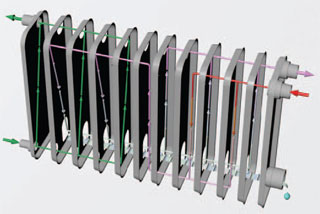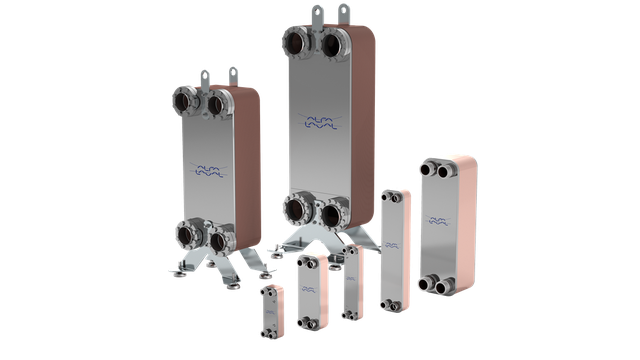CB
The Alfa Laval CB range of brazed plate heat exchangers feature efficient heat transfer with an extremely small footprint, making them ideal for demanding installations where space is at a premium. The CB range is used in HVAC heating/cooling, refrigeration, process heating/cooling, oil cooling, solar heating and many other applications.
The thin, corrugated stainless steel plates used in the CB design are brazed together with copper. This forms a self-contained unit that can handle both high pressures and high temperatures. And unlike traditional designs, the brazed plate heat exchanger consists solely of surfaces that actively contribute to heat transfer, resulting in significant increases in overall efficiency.
The CB range of brazed plate heat exchangers has numerous advantages over traditional heat exchangers in both industrial, HVAC and refrigeration installations. The exceptional heat transfer efficiency makes all CB units very compact. As a result, they can tackle large-capacity duties even though there is only limited installation space available.
The brazed construction also does away with gaskets, making CB units ideal in applications where temperatures and/or pressures are high. Examples include district heating and a wide range of heating, cooling and tap water solutions.
Alfa Laval is the world's leading manufacturer of brazed plate heat exchangers. This means solid experience in designing units that withstand high-pressure and high-temperature conditions, and in coping effectively with the structural stresses that results from these. Units in the CB range are available in many different sizes and capacities, with varying plate patterns and connections for particular duties and performance specifications. CB units can be configured as single-pass, dual-pass or multi-pass installations, according to project requirements.
All CB brazed heat exchanger units comply with the European Pressure Vessel Safety Directive, and can also be delivered according to other relevant standards and national codes, as required.
Cómo funciona

En los intercambiadores de calor de placas termosoldadas con cobre (CB), las superficies utilizadas para proporcionar la transferencia de calor de un medio a otro son placas delgadas de acero inoxidable corrugadas y apiladas una encima de la otra. Los dos medios están sellados dentro del paquete de placas mediante un sello de cobre soldado alrededor del borde de las placas. Esto da como resultado un intercambiador de calor que, a diferencia de los diseños tradicionales, consiste únicamente en superficies que contribuyen activamente a la transferencia de calor, lo que resulta en un aumento significativo de la eficiencia general.
Los canales formados entre las placas y los puertos de las esquinas están dispuestos de modo que los medios fluyan a través de canales alternos, siempre en un patrón de flujo a contracorriente para lograr la transferencia de calor más eficiente.
Los puntos de contacto entre las placas también están soldados, lo que ayuda a resistir los efectos de altas presiones y altas temperaturas. Los picos de presión y la temperatura rápida causan tensiones físicas sustanciales dentro de los materiales, y la investigación de Alfa Laval se ha centrado en los detalles de estos fenómenos para garantizar diseños que sean extremadamente resistentes y proporcionen una larga vida útil.

